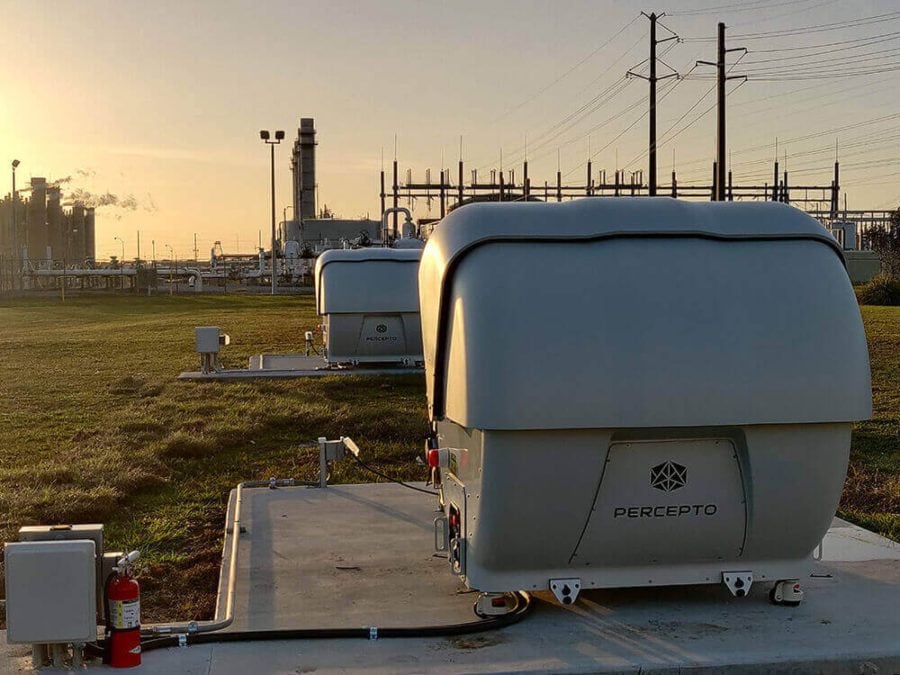Drone-in-a-Box Gets First Big Use Case with Hundreds of Autonomous Percepto Drones to Be Deployed for Florida Power & Light
BY Zacc Dukowitz
4 May 2022With DJI’s release of the DJI Dock to go with the Matrice 30 in March, the drone-in-a-box (DIB) concept went mainstream.
The idea of a drone-in-a-box is that the box—also called a nest, a dock, or a charging station—acts as a homebase for the drone, where it’s stored, charged, and where data can be offloaded.

Credit: Percepto
But to make the box idea useful, the drone has to be autonomous.
This is because the goal isn’t just for the drone to live in the dock, but also for it to be deployed autonomously from the dock, enabling regular, predictable data collection.
The potential benefits for the concept are huge. For security, agriculture, inspections, or any other scenario that requires periodic data collection, having a solution that uses a drone to automatically collect aerial data and then uses AI-powered software to analyze and report on that data presents a step change for the commercial usefulness of drones.
But the idea and the reality are two very different things.
While the technology now exists to do something like what we just described, regulatory hurdles make it hard to implement autonomous flight, in part because it requires BVLOS (Beyond Visual Line of Site) operations since, by definition, no pilot is present for the flight.
And yet despite these challenges, it looks like Florida Power & Light has figured out how to make it work.
FPL’s Drone-in-a-Box Rollout
In a recent statement, Percepto announced that FPL will be placing 13 autonomous drones at its facilities in West Palm Beach over the next year.
Over the next five years, the power company will scale up its use of DIBs until hundreds are operating at once, presenting what Percepto calls “the largest commercial autonomous drone project in the world.”

Credit: Percepto
The drones will be used to monitor substations and power distribution grids throughout the state of Florida. Constant monitoring will help reduce downtimes after severe weather, which Florida sees a lot of, allowing FPL personnel to respond quickly to outages by giving them the data they need to understand what has been damaged and exactly where the damage is located.
FPL’s visionary approach in adopting the latest drone technology will play a critical role in the electric grid of the future, and Percepto is thrilled its drones will help ensure vital infrastructure reliability to FPL’s customers.
– Ariel Avitan, Chief Commercial Officer at Percepto
The autonomous drones are all coordinated on a single platform called AIM (Autonomous Inspection and Monitoring). The platform allows the drones to be flown remotely, synchronizing their operations to ensure they’re getting full coverage of FPL’s assets.
To get regulatory approval for using these drones, FPL worked with Percepto to secure a nationwide waiver that gives it permission to do drone missions remotely and autonomously for surveillance and inspection purposes. The waiver allows FPL to conduct these operations at any site it owns or services.
[New BVLOS rules could be coming soon—read the recommendations from the FAA’s BVLOS Aviation Rulemaking Committee on the path forward.]
American Robotics Gets Seven New DIB Approvals
Another company that’s been successfully deploying DIBs is American Robotics.
In January of 2021 the FAA granted American Robotics the first nonemergency approval ever to operate automated drones BVLOS without a pilot present on-site. (Skyward received the first emergency approval for automated BVLOS without a person present.)

Credit: American Robotics
Since getting that approval, American Robotics has rolled out the use of its Scout drone for autonomous operations at 10 sites in eight different states—a substantial amount, given how new the technology is.
[Related read: American Drone Companies: A Master List]
Following up on this success, the company just announced that it has received FAA approval to use its drone without a human operator present at seven new sites, almost doubling the number of places where it can operate without a human pilot present.
Not only is this a milestone for American Robotics, but it is also another signal that we have reached an inflection point in commercial drone operations in the United States, and American Robotics is proud to be at the forefront of these industry advancements.
– Reese Mozer, Co-Founder and CEO of American Robotics
According to American Robotics, the seven new sites range from 0.1 square miles to 14 square miles and are located in North Dakota, Louisiana, New Mexico, Nevada, California, and South Carolina.
All seven sites can start autonomous operations with AR’s Scout immediately.


